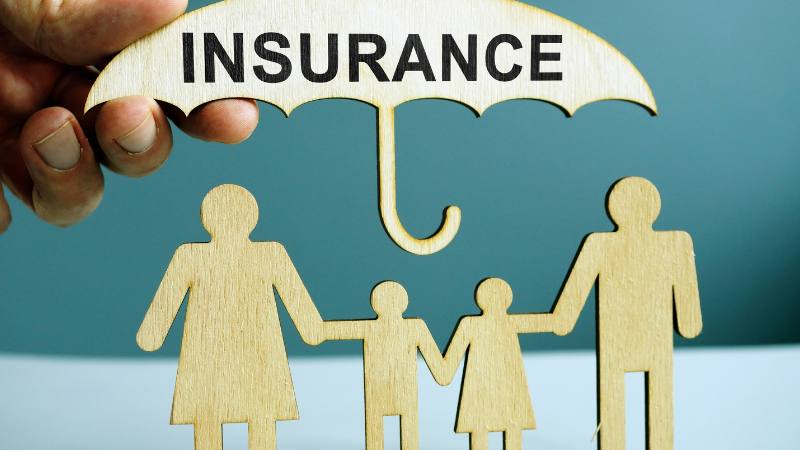Life Insurance Statistics Unveiled: Trends and Insights
If you’re considering purchasing life insurance, you’re not alone. However, before you buy, you may want to consider some vital life insurance statistics to make a better-informed decision.
According to a Forbes Advisor survey, at least three in four American adults have life insurance. Life insurance is a way to help protect your loved ones financially in the event of your unexpected death.
But what are the latest life insurance statistics? As of March 1, 2021, the top 10 life insurance companies reporting have a cumulative market share of 54.69%.
Total reported premiums for life insurance, including annuity considerations, deposit-type contract funds, other considerations, and accident and health, are $818,022,824,054.
Understanding life insurance trends and data is essential to make informed decisions about your financial future.
In this article, we’ll dive deeper into the latest life insurance statistics and industry trends to help you make the best decisions for you and your loved ones.
Understanding Life Insurance

Life insurance is a contract between you and an insurance company.
You pay a premium, and in exchange, the insurance company agrees to provide a death benefit to your beneficiaries upon your death.
Understanding life insurance can be overwhelming, but knowing the basics to make an informed decision is essential.
Types of Life Insurance
There are two main types of life insurance: term life insurance and permanent life insurance.
Term Life Insurance: This type covers a specific period, typically 10, 20, or 30 years. If you die during the term, the insurance company pays the death benefit to your beneficiaries. If you outlive the term, the policy expires, and you no longer have coverage. Term life insurance is often the most affordable option.
Permanent Life Insurance: This type covers your entire life as long as you pay the premiums. Permanent life insurance has a cash value component that grows over time, and you can borrow against it or withdraw it. There are different types of permanent life insurance, including whole and universal life insurance.
Whole Life Insurance: This permanent life insurance covers your entire life and has a fixed premium and death benefit. The cash value component grows at a guaranteed rate, and the policy may pay dividends.
Universal Life Insurance: This permanent life insurance provides flexibility in premium payments and death benefits. The cash value component grows based on the policy’s interest rate and may be invested in various options.
In summary, life insurance is a crucial tool to protect your loved ones in the event of death financially.
There are different types of life insurance to choose from, so it’s essential to understand each policy’s coverage, benefits, and death benefits.
Term life insurance is often the most affordable option, while permanent life insurance covers your entire life and has a cash value component.
Life Insurance Statistics and Demographics

Life insurance is an essential financial product that provides peace of mind to those who have dependents.
In the United States, life insurance ownership varies depending on demographic factors such as gender, age, and marital status.
Here are some key demographic trends in life insurance ownership among American adults.
Gender and Life Insurance
According to a survey by the Insurance Information Institute, women are less likely to own life insurance than men.
In 2023, 50 percent of women owned life insurance, compared to 54 percent of men. The survey also found that women are likelier to say they do not have enough coverage than men.
Life Insurance and Age
Age is another critical factor in life insurance ownership.
According to Statista, in 2023, 52 percent of Americans owned life insurance, up from 50 percent in 2022.
The survey also found that younger generations are less likely to own life insurance than older generations.
For example, only 29 percent of Gen Zers (born between 1997 and 2012) own life insurance, compared to 43 percent of millennials (born between 1981 and 1996).
Life Insurance and Marital Status
Marital status is another important factor in life insurance ownership.
According to the same Insurance Information Institute survey, married individuals are more likely to own life insurance than single individuals.
In 2023, 62 percent of married individuals owned life insurance, compared to 37 percent of single individuals.
The survey also found that parents of minor children were likelier to own life insurance than the general population (59 percent versus 52 percent).
In conclusion, life insurance ownership varies depending on demographic factors such as gender, age, and marital status.
While men are more likely to own life insurance than women, older and married individuals are more likely to own life insurance than younger and single individuals.
The Life Insurance Market

Life insurance is a crucial part of the financial planning process for many people.
It provides a safety net for loved ones in the event of an unexpected death. In the US, the life insurance industry is a significant part of the insurance market, with a market size of $143 billion in gross premiums in the second quarter of 2021 alone 1.
In this section, we will explore the life insurance market, including market share and companies, as well as the impact of the COVID-19 pandemic on the industry.
Market Share and Companies
The life insurance market is highly competitive, with many companies vying for market share.
According to the National Association of Insurance Commissioners (NAIC), the US’s top 10 life insurance companies have a cumulative market share of 54.69% 2. These companies include MetLife, Prudential, New York Life, and Northwestern Mutual.
In addition to these large companies, there are many smaller life insurance companies.
These companies may specialize in specific types of life insurance, such as term life or whole life insurance.
When choosing a life insurance policy, it is essential to research different companies and compare their offerings to find the best fit for your needs.
Impact of COVID-19 on Life Insurance
The COVID-19 pandemic has had a significant impact on the life insurance industry.
One of the most notable effects is the increased demand for life insurance. According to the 2023 Insurance Barometer Study conducted by LIMRA and Life Happens, a record-high proportion of consumers (39 percent) said they intend to purchase life insurance within the next year 3.
This proportion is higher for Gen Z adults (44 percent) and millennials (50 percent).
The pandemic has also led to changes in how life insurance policies are underwritten. Many insurance companies have adjusted their underwriting criteria to account for the increased risk of COVID-19.
For example, some companies may require applicants to disclose if they have tested positive for COVID-19 or have been in close contact with someone who has.
In conclusion, the life insurance market is essential to the insurance industry, with many companies competing for market share.
The COVID-19 pandemic has significantly impacted the industry, leading to increased demand for life insurance and changes in underwriting criteria.
When choosing a life insurance policy, it is essential to research different companies and compare their offerings to find the best fit for your needs.
Footnotes
Cost and Premiums of Life Insurance

Life insurance costs can vary significantly depending on factors, including the type of policy you choose and your demographics.
This section will explore the cost of life insurance by type and demographics.
Cost of Life Insurance by Type
There are two central life insurance policies: term life insurance and permanent coverage.
Term Life Insurance Policy
Term life insurance policies are generally the most affordable option. These policies cover a set period, typically 10, 20, or 30 years.
The premium for a term life insurance policy is based on several factors, including age, health, and the coverage you need.
Permanent Coverage
Permanent life insurance policies, such as whole life and universal life insurance, cover your entire life.
These policies are typically more expensive than term life insurance policies but offer additional benefits, such as cash value accumulation.
The premium for a permanent life insurance policy is based on several factors, including age, health, and the coverage you need.
Cost of Life Insurance by Demographics
Your demographics can also play a significant role in the cost of your life insurance policy.
Age
Younger individuals typically pay less for life insurance than older individuals.
This is because younger individuals are generally considered to be lower risk. As you age, the cost of your life insurance policy will typically increase.
Gender
In general, women pay less for life insurance than men.
This is because women tend to live longer than men and are therefore considered lower risk.
Health
Your health also plays a significant role in the cost of your life insurance policy.
Your premiums will likely be higher if you have a pre-existing medical condition or engage in risky behaviors like smoking.
In conclusion, the cost of your life insurance policy will depend on several factors, including the type of policy you choose and your demographics.
Shopping around and comparing quotes from multiple insurance providers is essential to get the best possible rate.
Benefits and Claims

Regarding life insurance, benefits and claims are two of the most important aspects.
In 2022, life insurance benefits and claims totaled $797.7 billion, including death benefits, annuity benefits, disability benefits, and other payouts.
According to the Insurance Information Institute, this was up from $790.9 billion in 2021.
Understanding the Death Benefit
The death benefit is the money paid to the beneficiaries when the insured dies.
This can help cover final expenses, such as funeral costs, and provide financial support for loved ones.
The death benefit amount can vary depending on the policy and the insured person’s age, health, and other factors.
It’s important to note that the death benefit is typically tax-free for the beneficiaries. This means they can use the entire amount to cover expenses and other needs.
Claiming Life Insurance
When the insured dies, the beneficiaries must file a claim for the death benefit.
This process can vary depending on the insurance company and the policy but typically involves submitting a death certificate and other documentation.
It’s essential to file the claim as soon as possible to avoid delays in receiving the death benefit. The insurance company will then review the claim and determine whether it meets the policy requirements. If approved, the death benefit will be paid out to the beneficiaries.
In addition to the death benefit, some life insurance policies may offer surrender benefits, allowing the insured person to cash out the policy before their death.
This can be helpful in certain situations, such as if the insured person no longer needs the coverage or money for unexpected expenses.
Understanding life insurance’s benefits and claims process can help you make informed decisions about your coverage and provide peace of mind for you and your loved ones.
Financial Aspects of Life Insurance

Life insurance is not just about providing financial assistance to your loved ones in case of your untimely death.
It can also serve as an investment and a tool for managing debts and expenses. In this section, we will explore the financial aspects of life insurance and how it can benefit you.
Life Insurance as an Investment
Life insurance policies can serve as an investment tool, providing a source of income and wealth transfer.
Whole life insurance policies, for example, have a cash value component that grows over time. This cash value can be borrowed against or withdrawn to supplement your retirement income or to fund other investments.
Income Replacement and Financial Security
One of the primary purposes of life insurance is to provide income replacement and financial security to your loved ones in case of death.
Life insurance can help ensure that your family can maintain their standard of living and cover expenses such as mortgage payments, education costs, and daily living expenses.
Managing Debts and Expenses
Life insurance can also be used to manage debts and expenses.
For example, if you have outstanding debts such as a mortgage, car loan, or credit card debt, life insurance can provide the funds needed to pay off these debts in case of death.
This can help alleviate financial stress for your loved ones during a difficult time.
When considering life insurance as a tool for managing debts and expenses, it is vital to consider the coverage needed to cover these expenses adequately. A financial advisor can help you determine the appropriate amount of coverage needed based on your circumstances.
In addition to the above, life insurance policies can provide other financial benefits such as annuities, direct premiums written, net investment income, other income, reinsurance, interest, and assets.
By understanding the financial aspects of life insurance, you can make informed decisions about your insurance needs and how it can benefit you and your loved ones.
Frequently Asked Questions
What is the current size of the life insurance market in the United States?
According to the Insurance Information Institute (III), the life insurance market in the United States was worth $161 billion in 2020.
What percentage of life insurance policies payout?
The III reports that in 2019, life insurance companies paid approximately $82 billion in death benefits to policyholders. In general, most life insurance policies payout as long as the policyholder has been truthful on their application and their cause of death is covered by the policy.
How many Americans currently have life insurance?
Roughly 60% of Americans have some form of life insurance policy, according to The Zebra. However, this number varies by age group and income level.
What are the most popular types of life insurance policies?
Term life insurance is the most popular type of life insurance policy, according to Forbes Advisor. This type of policy provides coverage for a specified period, usually 10-30 years. Whole life insurance, which provides coverage for the policyholder’s entire life, is also popular but tends to be more expensive.
What percentage of 30-year-olds have life insurance?
According to LIMRA, only 10% of 30-year-olds have individual life insurance policies. However, many 30-year-olds may have coverage through their employer’s group life insurance policy.
How many people are underinsured with their life insurance policy?
The III reports that 33% of Americans believe they are underinsured with their life insurance policy. This means they do not have enough coverage to meet their financial needs if they pass away. It is essential to regularly review your life insurance coverage to ensure it still meets your needs.







![What is the Average Life Insurance Cost Per Month [Includes Rate Charts]](https://walletimpact.com/wp-content/uploads/2020/07/Average-Life-Insurance-Rates-768x432.jpg)